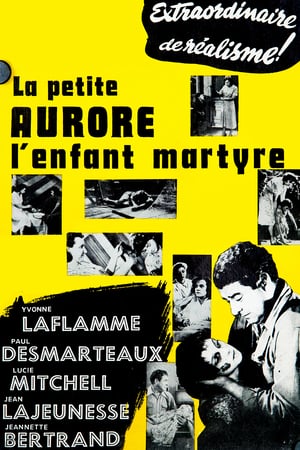 A 1952 film that seems destined to be the subject of a tug-of-war between those who say it’s one of the worst movies ever made and those who proclaim it a classic of Quebec cinema. The fact that such a controversy even exists, and continues to rage, proves the film has worth, and is far more than the French-Canadian MOMMIE DEAREST that so many have dismissively called it. A better comparison, I think, would be the vastly underrated Jack Ketchum adaptation THE GIRL NEXT DOOR, an unflinching depiction of child abuse that like LITTLE AURORE’S TRAGEDY (LA PETITE AURORE L’ENFANT MARTYRE) was fact-based.
A 1952 film that seems destined to be the subject of a tug-of-war between those who say it’s one of the worst movies ever made and those who proclaim it a classic of Quebec cinema. The fact that such a controversy even exists, and continues to rage, proves the film has worth, and is far more than the French-Canadian MOMMIE DEAREST that so many have dismissively called it. A better comparison, I think, would be the vastly underrated Jack Ketchum adaptation THE GIRL NEXT DOOR, an unflinching depiction of child abuse that like LITTLE AURORE’S TRAGEDY (LA PETITE AURORE L’ENFANT MARTYRE) was fact-based.
The incident that inspired this film has been classed as Canada’s first documented case of child abuse. The victim was the ten year old Aurore Gagnon, who on February 12, 1920 died at the hands of her stepmother Marie-Anne Houde and father Télesphore Gagnon, following years of abuse. Gagnon, who was imprisoned for his crimes but discharged after five years, attempted to block the release of this film, and succeeded in holding it off for several months (from its intended November 1951 premiere until April of ‘52) before his legal injunction was struck down. It was a massive hit, impacting audiences in its native land to such an extent that actress Lucie Mitchell, who plays Houde, was relegated to villainess roles for the remainder of her career.
The film was remade in 2005 as AURORE. Written and directed by Luc Dionne, AURORE presented the abuse visited on Aurore Gagnon (played by Marianne Fortier) in a far more subtle fashion than its predecessor, with much of the unpleasantness taking place off-screen. I say the former film, lurid and outrageous though it is, is the preferable one.
It begins with the twelve year old Aurore in a quandary after her beloved mother dies of a heart attack induced by Marie-Louise, a seemingly kind and helpful neighbor. But then Aurore’s father Theodore marries Marie-Louise and Aurore is forced to live with her, her young son Maurice and her infant child. All is reasonably pleasant until Aurore makes the mistake of revealing to Marie-Louise what she knows, inspiring her to abuse Aurore in order to keep her quiet.
Aurore tries to run away, and at one point is called back to the home of her aunt Melvina. Back home Marie-Louise, convinced that Aurore has revealed her crimes to Melvina, forces the girl to eat soap, burns her scalp with a curling iron and locks her in the cobweb-ridden attic. The following morning Marie-Louise tells Theodore that Aurore kissed Maurice, and he beats her with an axe handle—only to be overcome by guilt and vow never to do it again (when in reality Theodore beat his daughter regularly).
More abuse follows when Aurore reveals to a neighbor woman and a local priest what’s been happening. She has her hands burned on a stove and her face with an iron, is beaten with a strap and thrown down the attic stairs before the authorities finally intervene, but by then it’s too late.
All of this, keep in mind, takes great liberties with the actual facts of the case. Particularly galling is the depiction of Theodore Gagnon as a loving parent manipulated by his evil wife, when the reality of the situation was far different. Marie-Louise’s crimes are also distorted; she doesn’t kill her two former children here, as she did in reality, and the film ends with her getting sentenced to death, whereas in actuality her sentence was commuted and she ended up being released from prison in 1935.
The proceedings are laughably dated in most every aspect, from the stilted staging better suited to a 1950s TV drama (with set design to match) to the soap opera-ish music that pervades the soundtrack, forcibly alerting us to the melodramatic import of each scene. The depictions of child abuse were quite graphic for their time, and remain so today (child abuse being one of the few remaining screen taboos), although the way in which they’re presented seems absurdly overwrought by modern standards; director Jean-Yves Bigras makes sure to insert gratuitous facial close-ups to emphasize the pain Aurore is experiencing, and also the evil of her constantly smirking attacker.
And yet, silly though it all is, it’s inevitable that some authentically upsetting moments (such as the downright agonizing scalp-burning sequence) still shine through, and make for a film that, nearly seventy years after its premiere, still leaves a mark.
Vital Statistics
LITTLE AURORE’S TRAGEDY (LA PETITE AURORE L’ENFANT MARTYRE)
Renaissance Films Distribution/ Sainte-Geneviève/ Île Bizard
Director: Jean-Yves Bigras
Screenplay: Emile Asselin
(Based on a play by Emile Asselin)
Cinematography: Roger Racine
Editing: Jean-Yves Bigras
Cast: Yvonne Laflamme, Lucie Mitchell, Paul Desmarteaux, Jeanette Bertrand, Jean Lajeunesse, J. Léo Gagnon, Marc Forrez, Therese McKinnon, Nana de Varennes, Lucie Poitras, Rolland D’Amour, Adrien Laurion, André Poitras
